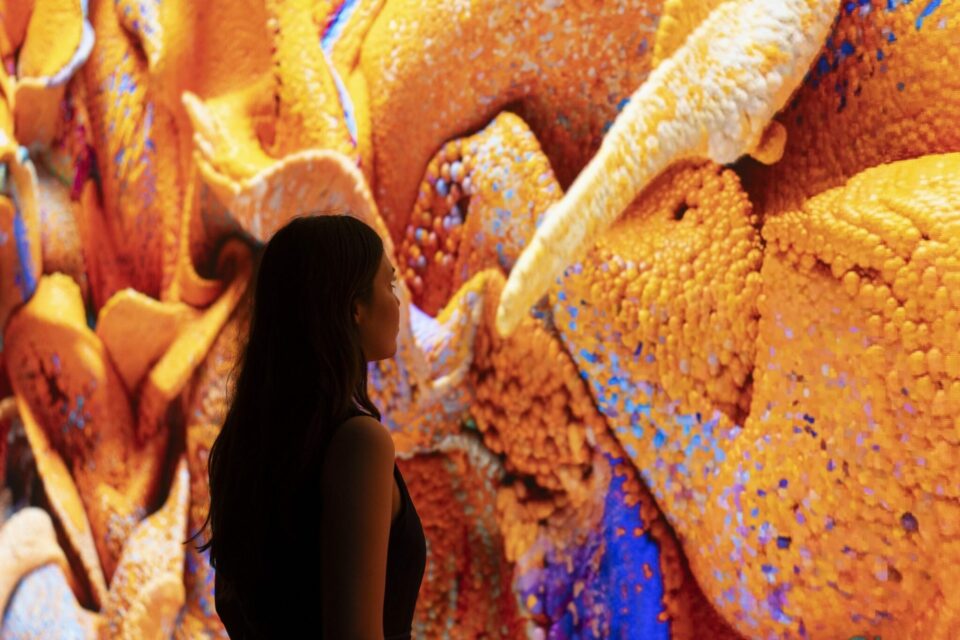Nam June Paik (1932-2006) is recognised as the “Father of Video Art.” He used what was considered new technology at the time – such as TVs and videotapes – to create memorable experiences that prompted audiences to reflect on their relationship with technology. For instance, his multimedia installation Electronic Superhighway Continental U.S, Alaska, Hawaii (1995) showed footage from each US state across 51 neon-lined screens. In this way, he simultaneously engaged with the country’s “interstate highway system, cable television and the emergent internet of the 1990s.” Hans Ulrich Obrist, the Artistic Director of Serpentine Galleries, reflects on the multimedia pioneer’s work and muses that “the Paiks of our time, of course, are now working with the Internet, digital images, and artificial intelligence. Their works and thoughts again are an early alarm system for the developments ahead of us.” Refik Anadol (b. 1985) is one of them. The artist creates digital, large-scale public installations that present real-time generative environments made with AI. His exhibition Echoes of the Earth: Living Archive displays his years-long experimentation with visual data in a selection of abstract underwater landscapes and verdant rainforests.

Anadol combines AI and art to raise awareness of the climate crisis by visualising a vast amount of information. For example, his 2023 installation Artificial Realities: Coral was created from 135 million coral images openly accessible on the internet. He then transformed this data into a sprawling multi-channel experience. The site-specific piece was first set in the Davos Congress Centre, Switzerland, where attendees were welcomed into a room filled with coral-like configurations shown across two enormous LED screens. At Serpentine North, viewers see swirling structures of pink, orange, white and teal. These perfect underwater forms bob imperceptibly as though moved by a current in a perfectly blue oceanscape. After a while, these scenes are destabilised to reveal a more abstract sequence of shifting spots made from the colours we’ve seen before. This is an AI’s imagination of the world below sea-level and Anadol uses it to demonstrate collaboration between humans, machines and nature – one that can drive change.
Echoes of the Earth also features the UK premiere of Anadol’s newest project. This is called Living Archive: Large Nature Model and it was first presented at the 54th annual World Economic Forum in Davos-Klosters, Switzerland, in January 2024. Now, it covers the walls of Serpentine North with what is an AI model’s interpretation of a rainforest. It is the first installation created using The Large Natural Model, the first open-source generative AI dedicated to nature. The system uses “nature’s inherent intelligence” as opposed to just human intellect and was developed with key institutions, including the Smithsonian Institution and London’s Natural History Museum. Anadol and his team travelled to these regions in Australia and Indonesia and worked closely with a Yawanawá family, who are part of an Indigenous community living in the Amazon, so that they could add “new sounds, images, climate information”. In an interview with Ravail Khan from Designboom, Anadol explains: “We have a responsibility as a studio to not just offer beautiful virtual worlds with AI and art, but to highlight that we have something incredibly important that we have perhaps lost, and find a new way to connect with nature through technology.”

Decades after Paik, computing is a ubiquitous part of our lives. Anadol makes use of the technologies of today to reframe how we look at the world around us. Part of what makes his work so mesmerising is his intentional engagement with the ways that we interpret visual information. We see countless representations of nature everyday, from advertisements to social media. His practice revolves around showing us new ways of perceiving what we’ve labelled as familiar, challenging us to question why we might take coral and rainforests for granted. He states: “AI’s role is not just making our lives easy or making a better product. It is not just another tool for our egocentric belief systems. AI has to be in service of humanity, and bring more clarity, positivity, and solutions to our problems. And that is defined by humans.”
Serpentine North, Echoes of the Earth: Living Archive | Until 7 April
Words: Diana Bestwish Tetteh
Image Credits:
- Refik Anadol, Artificial Realities: Coral, 2023. Courtesy Refik Anadol Studios.
- Refik Anadol, Echoes of the Earth: Living Archive, 2024. Installation view, Serpentine North. Photo: Hugo Glendinning. Courtesy Refik Anadol Studio and Serpentine.
- Refik Anadol, Artificial Realities: Coral, 2023. Courtesy Refik Anadol Studios.





